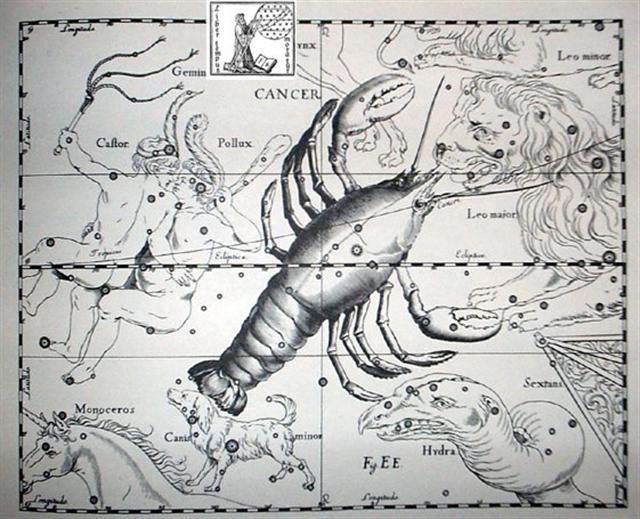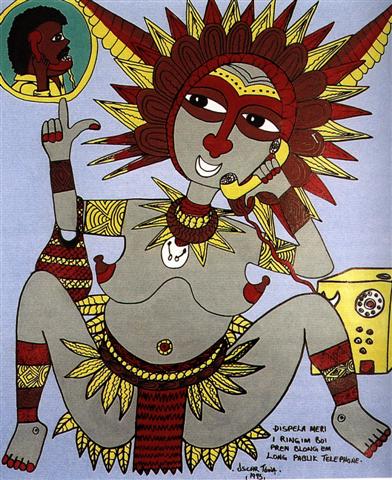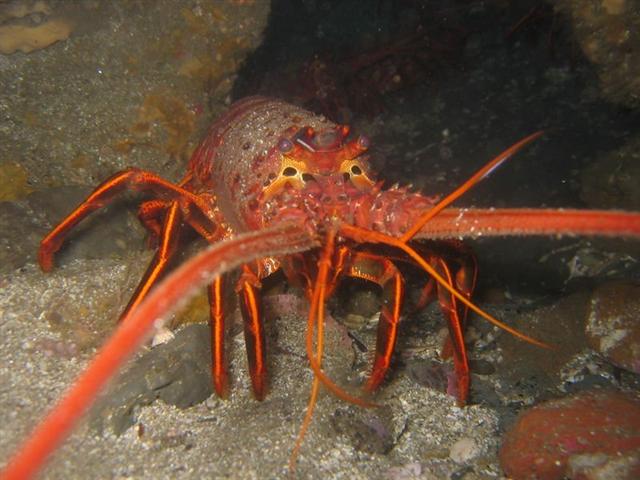The dream soul of Hau Maka had moved through the night
and reached the 8th land. This suggests she may have arrived to the
right ascension line for the 8th hour, i.e. to the region of Cancer:

The first significant star in Cancer was at the Full Moon in
Te Maro 8:
Here the C text has a birth (hanau) type
of glyph:
 |
 |
|
hanau |
Cb4-23 |

... In A Girl Rings her Boyfriend, a
woman who wears traditional dress, including
a fiber apron and feather headdress, uses a
payphone to talk with her boyfriend. Closer
examination reveals her polished nails and a
bag that looks like a striped bilum
but is worn like a Western-style handbag,
signs of her boldness that are just as
obvious as placing a telephone call to a
man. The displayed posture in which she
sits, often used to depict female ancestors
as images of fecundity and prosperity, seems
incongrous, perhaps underscoring Towa's
perception of the inappropriateness of her
behavior. (The artist Oscar Towa is from
Papua New Guinea and the quotation from
D'Alleva.)
Her navel ornament counts as 8, the symbol of
which identifies where one cycle is meeting
another.
... And then the bone spoke;
it was there in the fork of the tree: Why do you
want a mere bone, a round thing in the branches
of a tree? said the head of One Hunaphu when it
spoke to the maiden. You don't want it, she was
told. I do want it, said the maiden. Very well.
Stretch out your right hand here, so I can see
it, said the bone. Yes, said the maiden. She
stretched out her right hand, up there in front
of the bone. And then the bone spit out its
saliva, which landed squarely in the hand of the
maiden. And then she looked in her hand, she
inspected it right away, but the bone's saliva
wasn't in her hand. It is just a sign I have
given you, my saliva, my spittle. This, my head,
has nothing on it - just bone, nothing of meat.
It's just the same with the head of a great
lord: it's just the flesh that makes his face
look good. And when he dies, people get
frightened by his bones. After that, his son is
like his saliva, his spittle, in his being,
whether it be the son of a lord or the son of a
craftsman, an orator.
The father does not disappear, but goes on being
fulfilled. Neither dimmed nor destroyed is the
face of a lord, a warrior, craftsman, an orator.
Rather, he will leave his daughters and sons. So
it is that I have done likewise through you. Now
go up there on the face of the earth; you will
not die. Keep the word. So be it, said the head
of One and Seven Hunaphu - they were of one mind
when they did it ...
| Te
ragi |
tagata
- ragi |
kua
hakagana - ki te maro |
 |
 |
 |
|
Cb5-1 (392 + 95) |
Cb5-2 |
Cb5-3 |
|
CLOSE TO THE SUN: |
|
SHANG WEI (Higher Guard) = κ Cephei
(305.2), θ Sagittae (305.4),
TSEEN FOO (Heavenly
Raft)
= θ Aquilae (Ant.)
(305.6), ξ Capricorni (305.8)
*264.0 = *305.4 - *41.4 |
TSO KE (Left Flag) = ρ Aquilae
(306.3) |
GREDI
(Goat) = α Capricorni
(307.2), σ Capricorni (307.5),
ALSHAT (The Sheep) = ν Capricorni
(307.9) |
|
... Väinämöinen set
about building a boat, but when it came
to the prow and the stern, he found he
needed three words in his rune that he
did not know, however he sought for
them. In vain he looked on the heads of
the swallows, on the necks of the swans,
on the backs of the geese, under the
tongues of the reindeer. He found a
number of words, but not those he
needed. Then he thought of seeking them
in the realm of Death, Tuonela, but in
vain. He escaped back to the world of
the living only thanks to his potent
magic. He was still missing his three
runes. He was then told by a shepherd to
search in the mouth of Antero Vipunen,
the giant ogre. The road, he was told,
went over swords and sharpened axes.
Ilmarinen made shoes, shirt and gloves
of iron for him, but warned him that he
would find the great Vipunen dead.
Nevertheless, the hero went. The giant
lay underground, and trees grew over his
head. Väinämöinen found his way to the
giant's mouth, and planted his iron
staff in it. The giant awoke and
suddenly opened his huge mouth.
Väinämöinen slipped into it and was
swallowed. As soon as he reached the
enormous stomach, he thought of getting
out. He built himself a raft and floated
on it up and down inside the giant ... |
|
Jan 20 (385) |
21 |
22 |
|
'Dec 24 (CHRISTMAS EVE) |
25 |
26 (360) |
|
"Dec 10 (*264.0 = *305.4 - *41.4) |
11 (345) |
12 |
|
NOV 17 (321 = 385 - 64) |
18 |
19 |
|
DAY 305 (= 321 - 16) |
306 |
307 |
 |
|
CLOSE TO THE FULL MOON: |
|
8h (121.7)
χ Gemini (121.0),
NAOS
= ζ Puppis
(121.3) |
ρ
Puppis (122.0),
HEAP OF FUEL
= μ Cancri
(122.1),
ζ
Monocerotis (122.3), ψ
Cancri (122.6),
REGOR (Roger backwards) =
γ
Velorum
(122.7) |
TEGMINE = ζ Cancri
(123.3) |
|
He bore a
grievous weight of dry wood ... |
|
July 20 |
21 (202) |
22 (22 / 7 → π) |
|
'June 24 (DAY OF ST JOHN) |
25 (202 - 26) |
26 (177 = 6 * 29½) |
|
"June 9 (*121 - *41 = *80) |
TE
MARO 10 (161 = 73 + 88) |
11 |
|
MAY 17 (*121 - *64 = *57) |
18 (138
= 202 - 64) |
19 |
|
DAY 121 (= 11 * 11) |
122 |
123 |
.jpg) |
| tagata mau
matagi |
ihe toga maa |
ura hia |
tagata maú
kihikihi erua |
|
Ura. Ura, lobster. Ûra, flame,
blaze (ûra ahi), to become furious (with
manava as subject: ku-ûra-á te manava).
Úraúra, bright red. Vanaga. 1. Crayfish,
lobster, prawn. P Mgv.: ura, crayfish.
Mq.: uá, lobster. Ta.: oura,
crayfish, lobster. 2. Fire, burning, to be in
flames; uraga, combustion, flame, torch;
hakaura, to cause to glow, to kindle, to
light. P Mgv., Ta.: ura, a flame, to
burn. Mq: uá, id. Uraga, burden,
load, weight. Uraura, vermilion, scarlet.
P Pau.: kurakura, red. Mgv.: uraura,
an inflamed countenance. Mq.: uáuá, red,
ruddy. Ta.: uraura, red. Churchill.

Koura. 1. Fry, spawn, roe. 2. Flea. P
Mgv.: ura, crayfish, lobster. Mq.:
koua, ua, id. Ta.: oura, id.
The preface ko to the stem ula
distinguishes the Tongafiti. We therefore assign
the word in Rapanui and Tahiti to a Tongafiti
source, in Mangareva to a Proto-Samoan source,
and Marquesas shows both ... Rapanui is the only
language which defines the flea otherwise than
in terms of the louse, commonly kutufiti
the jumping louse. Pediculus is ancestral
in the South Sea, the flea seams to have been
contributed by the first of the explorers.
Churchill. |
 |
 |
 |
 |
|
Cb5-4 |
Cb5-5 |
Cb5-6 |
Cb5-7 (101) |
|
CLOSE TO THE
FULL MOON: |
|
AL
TARF (The End) = β Cancri
(124.3)
RAS
ALGETHI (α Herculis)
|
χ Cancri
(125.2),
BRIGHT
FIRE
= λ Cancri
(125.4)
*84.0 = *125.4 - *41.4 |
AVIOR = ε Carinae
(126.4), φ Cancri (126.8)
*85.0 = *126.4 - *41.4 |
ο Ursa Majoris (127.4)
*86.0 = *127.4 - *41.4 |
|
July
23 (204) |
24 |
25 (193 + 13 = 175 +
31) |
26 |
|
"June
12 |
13
(164) |
14 |
TE MARO 15 |
 |
 |
 |
 |
 |
|
Ga3-1 (60) |
Ga3-2 (61) |
Ga3-3 |
Ga3-4 |
|
CLOSE TO THE SUN: |
|
July
23 (204) |
24 |
25 (193 + 13 = 175 +
31) |
26 |
In the G text manu kake (the 'climbing'
bird) preceded the birth of a new land at a time when the
Bright Fire would be close to the Full Moon.
...
Lobster said to Flounder:
'Let us-two hide from each other, see who is
best at that.' Flounder agreed to play this
game. Lobster went to a hole in the coral, hid
his body; but his feelers stuck out, he could
not hide them. Flounder knew where he was, found
him. Said Flounder;
'Now it is my turn.' He stirred up a cloud of
mud and scooted into it. Then he returned to
Lobster's side, so quietly that Lobster did not
know he was there. 'Here I am
sir, Lobster!' Lobster was so angry at being
beaten that he stamped on the fish and smashed
him flat. Cried Flounder; 'Now I've got one eye
in the mud!' Therefore Lobster gouged it out for
him and roughly stuck it back on top. This is
the reason why men tread on the Flounder, but
can always see the Lobster's feelers outside his
hole ...

|










.jpg)







